Strategic Change Management & Organisational Development at LPHY
VerifiedAdded on 2023/06/10
|8
|2714
|314
Report
AI Summary
This report examines change management and organizational development within LPHY, a local charity organization supporting hospice care. It identifies strategic changes undertaken by LPHY in response to challenges like increasing employee turnover, decreasing profits, fundraising problems due to the pandemic, lack of skilled employees, and inadequate IT infrastructure. The report details the rationales behind these changes, including hiring skilled employees, developing IT infrastructure, and implementing effective performance management. It applies Lewin's change management model to outline a planned change approach, focusing on unfreezing, changing, and refreezing stages. Furthermore, the report identifies potential organizational and individual resistance to the proposed changes, such as increasing costs, habit, and fear of the unseen future. The conclusion emphasizes the importance of change management for organizational success in overcoming challenges and leveraging opportunities.
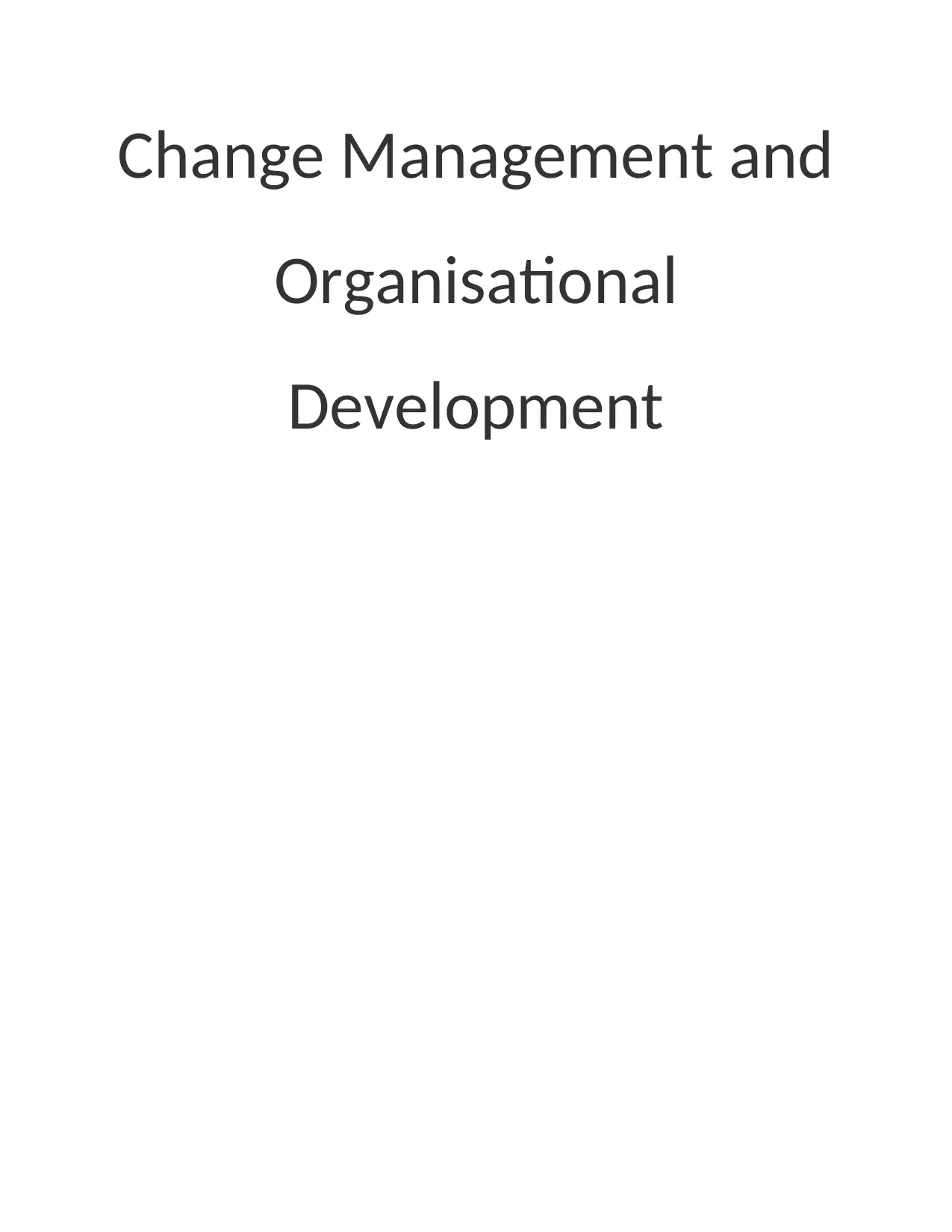
Change Management and
Organisational
Development
Organisational
Development
Paraphrase This Document
Need a fresh take? Get an instant paraphrase of this document with our AI Paraphraser
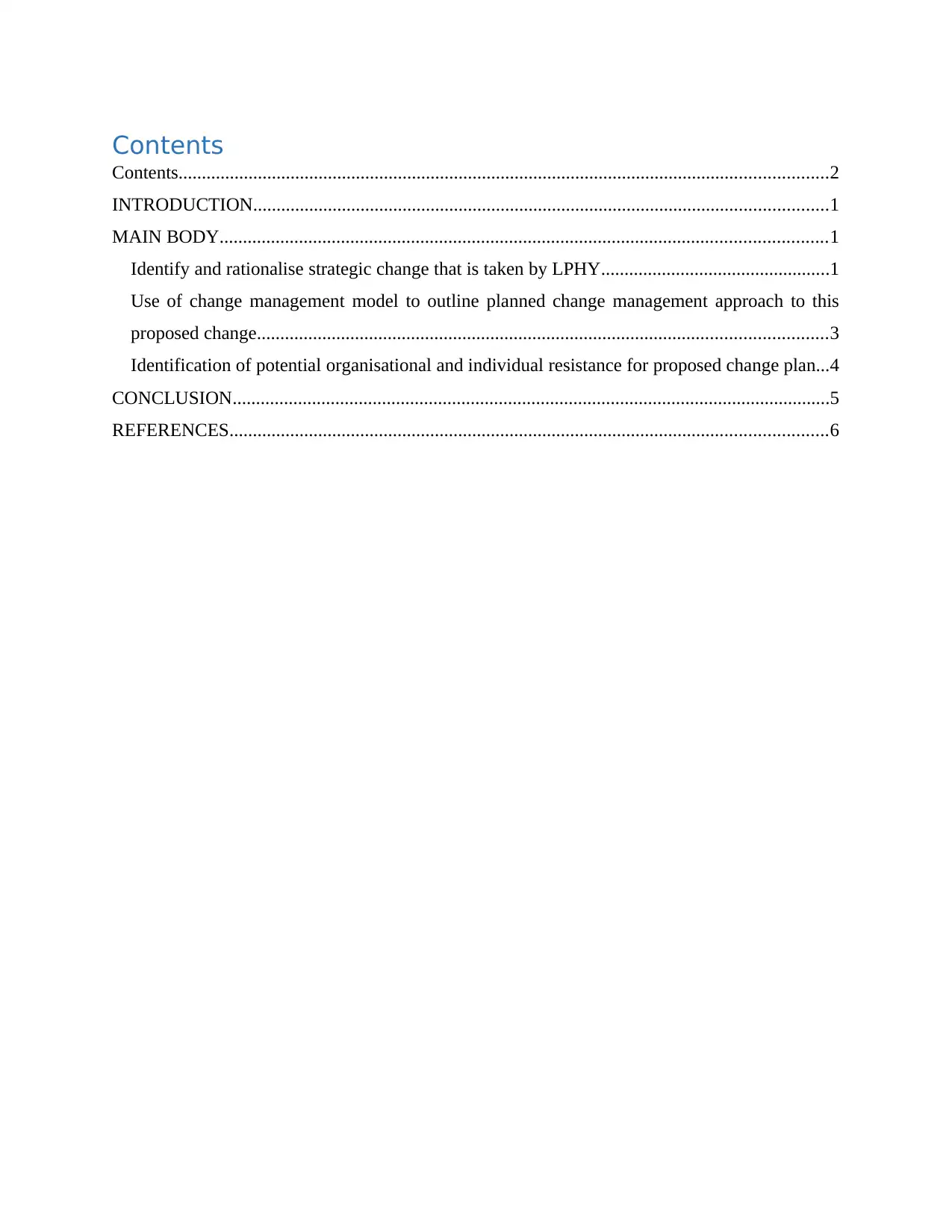
Contents
Contents...........................................................................................................................................2
INTRODUCTION...........................................................................................................................1
MAIN BODY..................................................................................................................................1
Identify and rationalise strategic change that is taken by LPHY.................................................1
Use of change management model to outline planned change management approach to this
proposed change..........................................................................................................................3
Identification of potential organisational and individual resistance for proposed change plan...4
CONCLUSION................................................................................................................................5
REFERENCES................................................................................................................................6
Contents...........................................................................................................................................2
INTRODUCTION...........................................................................................................................1
MAIN BODY..................................................................................................................................1
Identify and rationalise strategic change that is taken by LPHY.................................................1
Use of change management model to outline planned change management approach to this
proposed change..........................................................................................................................3
Identification of potential organisational and individual resistance for proposed change plan...4
CONCLUSION................................................................................................................................5
REFERENCES................................................................................................................................6
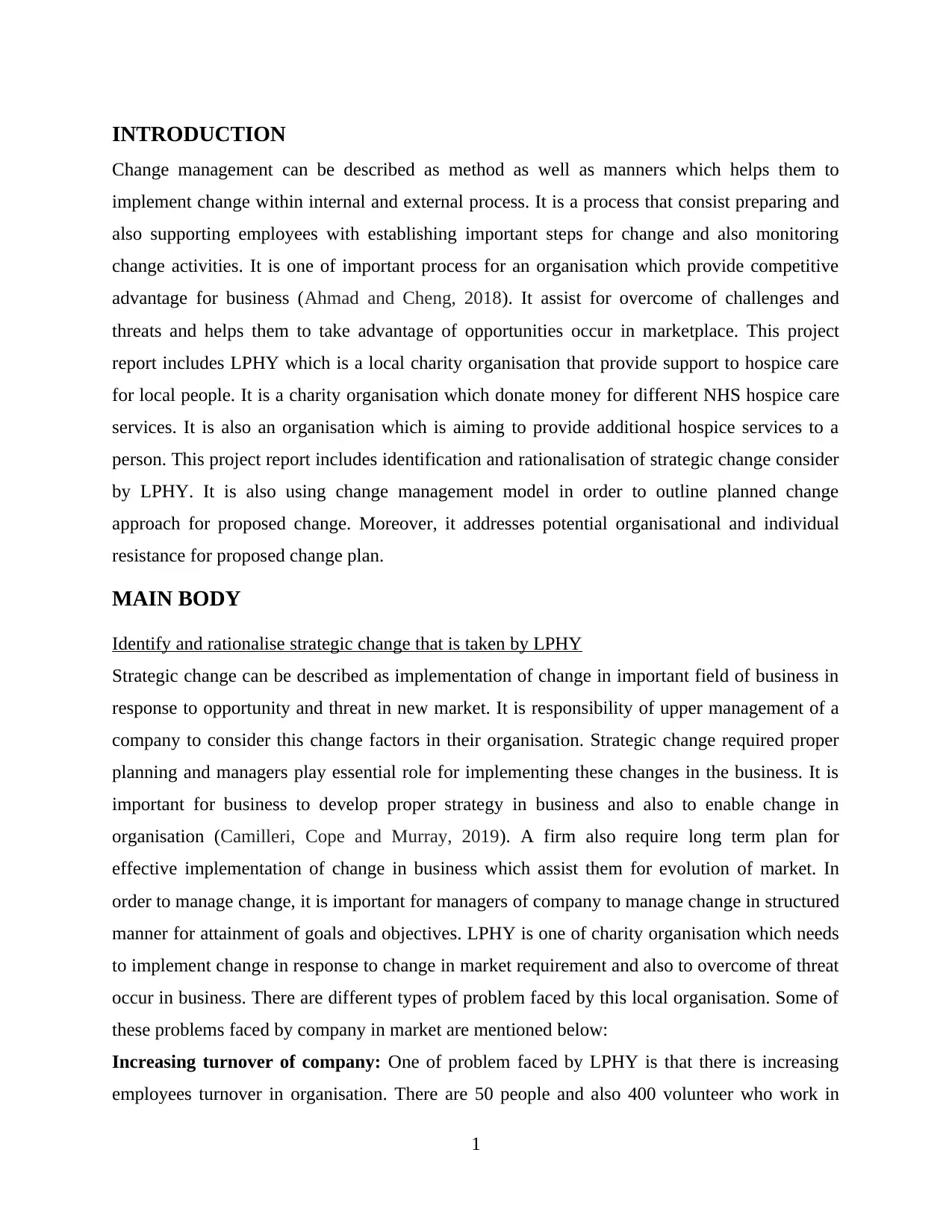
INTRODUCTION
Change management can be described as method as well as manners which helps them to
implement change within internal and external process. It is a process that consist preparing and
also supporting employees with establishing important steps for change and also monitoring
change activities. It is one of important process for an organisation which provide competitive
advantage for business (Ahmad and Cheng, 2018). It assist for overcome of challenges and
threats and helps them to take advantage of opportunities occur in marketplace. This project
report includes LPHY which is a local charity organisation that provide support to hospice care
for local people. It is a charity organisation which donate money for different NHS hospice care
services. It is also an organisation which is aiming to provide additional hospice services to a
person. This project report includes identification and rationalisation of strategic change consider
by LPHY. It is also using change management model in order to outline planned change
approach for proposed change. Moreover, it addresses potential organisational and individual
resistance for proposed change plan.
MAIN BODY
Identify and rationalise strategic change that is taken by LPHY
Strategic change can be described as implementation of change in important field of business in
response to opportunity and threat in new market. It is responsibility of upper management of a
company to consider this change factors in their organisation. Strategic change required proper
planning and managers play essential role for implementing these changes in the business. It is
important for business to develop proper strategy in business and also to enable change in
organisation (Camilleri, Cope and Murray, 2019). A firm also require long term plan for
effective implementation of change in business which assist them for evolution of market. In
order to manage change, it is important for managers of company to manage change in structured
manner for attainment of goals and objectives. LPHY is one of charity organisation which needs
to implement change in response to change in market requirement and also to overcome of threat
occur in business. There are different types of problem faced by this local organisation. Some of
these problems faced by company in market are mentioned below:
Increasing turnover of company: One of problem faced by LPHY is that there is increasing
employees turnover in organisation. There are 50 people and also 400 volunteer who work in
1
Change management can be described as method as well as manners which helps them to
implement change within internal and external process. It is a process that consist preparing and
also supporting employees with establishing important steps for change and also monitoring
change activities. It is one of important process for an organisation which provide competitive
advantage for business (Ahmad and Cheng, 2018). It assist for overcome of challenges and
threats and helps them to take advantage of opportunities occur in marketplace. This project
report includes LPHY which is a local charity organisation that provide support to hospice care
for local people. It is a charity organisation which donate money for different NHS hospice care
services. It is also an organisation which is aiming to provide additional hospice services to a
person. This project report includes identification and rationalisation of strategic change consider
by LPHY. It is also using change management model in order to outline planned change
approach for proposed change. Moreover, it addresses potential organisational and individual
resistance for proposed change plan.
MAIN BODY
Identify and rationalise strategic change that is taken by LPHY
Strategic change can be described as implementation of change in important field of business in
response to opportunity and threat in new market. It is responsibility of upper management of a
company to consider this change factors in their organisation. Strategic change required proper
planning and managers play essential role for implementing these changes in the business. It is
important for business to develop proper strategy in business and also to enable change in
organisation (Camilleri, Cope and Murray, 2019). A firm also require long term plan for
effective implementation of change in business which assist them for evolution of market. In
order to manage change, it is important for managers of company to manage change in structured
manner for attainment of goals and objectives. LPHY is one of charity organisation which needs
to implement change in response to change in market requirement and also to overcome of threat
occur in business. There are different types of problem faced by this local organisation. Some of
these problems faced by company in market are mentioned below:
Increasing turnover of company: One of problem faced by LPHY is that there is increasing
employees turnover in organisation. There are 50 people and also 400 volunteer who work in
1
⊘ This is a preview!⊘
Do you want full access?
Subscribe today to unlock all pages.

Trusted by 1+ million students worldwide
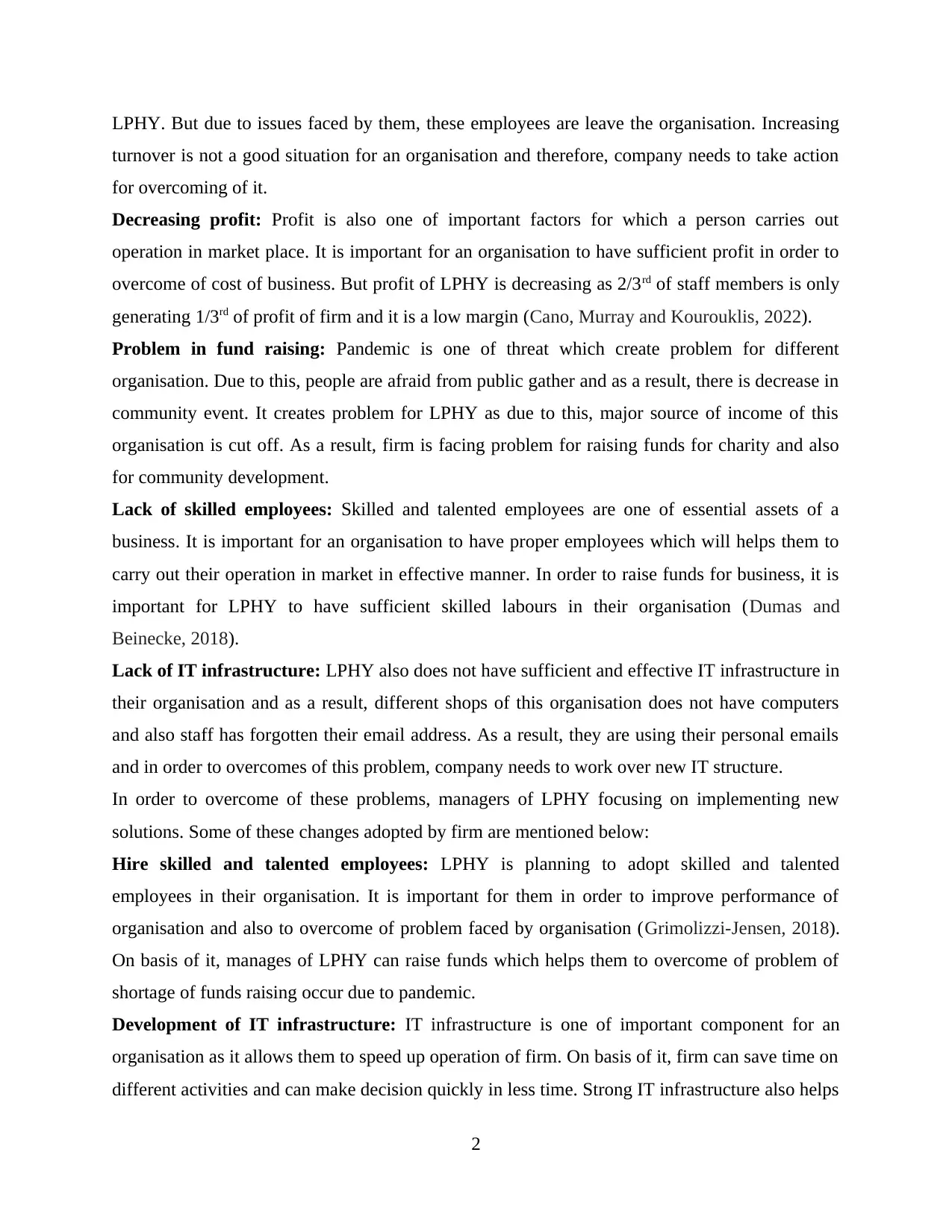
LPHY. But due to issues faced by them, these employees are leave the organisation. Increasing
turnover is not a good situation for an organisation and therefore, company needs to take action
for overcoming of it.
Decreasing profit: Profit is also one of important factors for which a person carries out
operation in market place. It is important for an organisation to have sufficient profit in order to
overcome of cost of business. But profit of LPHY is decreasing as 2/3rd of staff members is only
generating 1/3rd of profit of firm and it is a low margin (Cano, Murray and Kourouklis, 2022).
Problem in fund raising: Pandemic is one of threat which create problem for different
organisation. Due to this, people are afraid from public gather and as a result, there is decrease in
community event. It creates problem for LPHY as due to this, major source of income of this
organisation is cut off. As a result, firm is facing problem for raising funds for charity and also
for community development.
Lack of skilled employees: Skilled and talented employees are one of essential assets of a
business. It is important for an organisation to have proper employees which will helps them to
carry out their operation in market in effective manner. In order to raise funds for business, it is
important for LPHY to have sufficient skilled labours in their organisation (Dumas and
Beinecke, 2018).
Lack of IT infrastructure: LPHY also does not have sufficient and effective IT infrastructure in
their organisation and as a result, different shops of this organisation does not have computers
and also staff has forgotten their email address. As a result, they are using their personal emails
and in order to overcomes of this problem, company needs to work over new IT structure.
In order to overcome of these problems, managers of LPHY focusing on implementing new
solutions. Some of these changes adopted by firm are mentioned below:
Hire skilled and talented employees: LPHY is planning to adopt skilled and talented
employees in their organisation. It is important for them in order to improve performance of
organisation and also to overcome of problem faced by organisation (Grimolizzi-Jensen, 2018).
On basis of it, manages of LPHY can raise funds which helps them to overcome of problem of
shortage of funds raising occur due to pandemic.
Development of IT infrastructure: IT infrastructure is one of important component for an
organisation as it allows them to speed up operation of firm. On basis of it, firm can save time on
different activities and can make decision quickly in less time. Strong IT infrastructure also helps
2
turnover is not a good situation for an organisation and therefore, company needs to take action
for overcoming of it.
Decreasing profit: Profit is also one of important factors for which a person carries out
operation in market place. It is important for an organisation to have sufficient profit in order to
overcome of cost of business. But profit of LPHY is decreasing as 2/3rd of staff members is only
generating 1/3rd of profit of firm and it is a low margin (Cano, Murray and Kourouklis, 2022).
Problem in fund raising: Pandemic is one of threat which create problem for different
organisation. Due to this, people are afraid from public gather and as a result, there is decrease in
community event. It creates problem for LPHY as due to this, major source of income of this
organisation is cut off. As a result, firm is facing problem for raising funds for charity and also
for community development.
Lack of skilled employees: Skilled and talented employees are one of essential assets of a
business. It is important for an organisation to have proper employees which will helps them to
carry out their operation in market in effective manner. In order to raise funds for business, it is
important for LPHY to have sufficient skilled labours in their organisation (Dumas and
Beinecke, 2018).
Lack of IT infrastructure: LPHY also does not have sufficient and effective IT infrastructure in
their organisation and as a result, different shops of this organisation does not have computers
and also staff has forgotten their email address. As a result, they are using their personal emails
and in order to overcomes of this problem, company needs to work over new IT structure.
In order to overcome of these problems, managers of LPHY focusing on implementing new
solutions. Some of these changes adopted by firm are mentioned below:
Hire skilled and talented employees: LPHY is planning to adopt skilled and talented
employees in their organisation. It is important for them in order to improve performance of
organisation and also to overcome of problem faced by organisation (Grimolizzi-Jensen, 2018).
On basis of it, manages of LPHY can raise funds which helps them to overcome of problem of
shortage of funds raising occur due to pandemic.
Development of IT infrastructure: IT infrastructure is one of important component for an
organisation as it allows them to speed up operation of firm. On basis of it, firm can save time on
different activities and can make decision quickly in less time. Strong IT infrastructure also helps
2
Paraphrase This Document
Need a fresh take? Get an instant paraphrase of this document with our AI Paraphraser
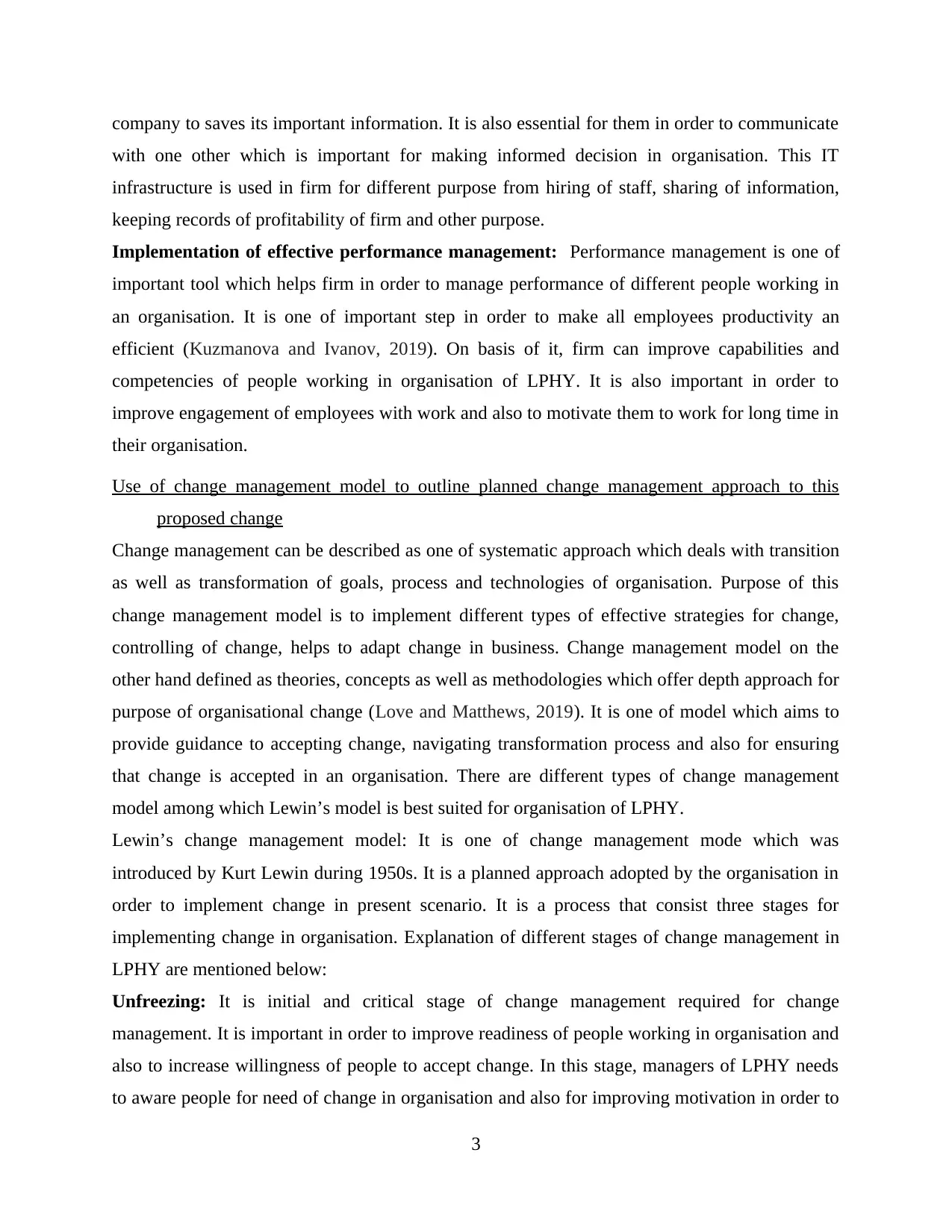
company to saves its important information. It is also essential for them in order to communicate
with one other which is important for making informed decision in organisation. This IT
infrastructure is used in firm for different purpose from hiring of staff, sharing of information,
keeping records of profitability of firm and other purpose.
Implementation of effective performance management: Performance management is one of
important tool which helps firm in order to manage performance of different people working in
an organisation. It is one of important step in order to make all employees productivity an
efficient (Kuzmanova and Ivanov, 2019). On basis of it, firm can improve capabilities and
competencies of people working in organisation of LPHY. It is also important in order to
improve engagement of employees with work and also to motivate them to work for long time in
their organisation.
Use of change management model to outline planned change management approach to this
proposed change
Change management can be described as one of systematic approach which deals with transition
as well as transformation of goals, process and technologies of organisation. Purpose of this
change management model is to implement different types of effective strategies for change,
controlling of change, helps to adapt change in business. Change management model on the
other hand defined as theories, concepts as well as methodologies which offer depth approach for
purpose of organisational change (Love and Matthews, 2019). It is one of model which aims to
provide guidance to accepting change, navigating transformation process and also for ensuring
that change is accepted in an organisation. There are different types of change management
model among which Lewin’s model is best suited for organisation of LPHY.
Lewin’s change management model: It is one of change management mode which was
introduced by Kurt Lewin during 1950s. It is a planned approach adopted by the organisation in
order to implement change in present scenario. It is a process that consist three stages for
implementing change in organisation. Explanation of different stages of change management in
LPHY are mentioned below:
Unfreezing: It is initial and critical stage of change management required for change
management. It is important in order to improve readiness of people working in organisation and
also to increase willingness of people to accept change. In this stage, managers of LPHY needs
to aware people for need of change in organisation and also for improving motivation in order to
3
with one other which is important for making informed decision in organisation. This IT
infrastructure is used in firm for different purpose from hiring of staff, sharing of information,
keeping records of profitability of firm and other purpose.
Implementation of effective performance management: Performance management is one of
important tool which helps firm in order to manage performance of different people working in
an organisation. It is one of important step in order to make all employees productivity an
efficient (Kuzmanova and Ivanov, 2019). On basis of it, firm can improve capabilities and
competencies of people working in organisation of LPHY. It is also important in order to
improve engagement of employees with work and also to motivate them to work for long time in
their organisation.
Use of change management model to outline planned change management approach to this
proposed change
Change management can be described as one of systematic approach which deals with transition
as well as transformation of goals, process and technologies of organisation. Purpose of this
change management model is to implement different types of effective strategies for change,
controlling of change, helps to adapt change in business. Change management model on the
other hand defined as theories, concepts as well as methodologies which offer depth approach for
purpose of organisational change (Love and Matthews, 2019). It is one of model which aims to
provide guidance to accepting change, navigating transformation process and also for ensuring
that change is accepted in an organisation. There are different types of change management
model among which Lewin’s model is best suited for organisation of LPHY.
Lewin’s change management model: It is one of change management mode which was
introduced by Kurt Lewin during 1950s. It is a planned approach adopted by the organisation in
order to implement change in present scenario. It is a process that consist three stages for
implementing change in organisation. Explanation of different stages of change management in
LPHY are mentioned below:
Unfreezing: It is initial and critical stage of change management required for change
management. It is important in order to improve readiness of people working in organisation and
also to increase willingness of people to accept change. In this stage, managers of LPHY needs
to aware people for need of change in organisation and also for improving motivation in order to
3
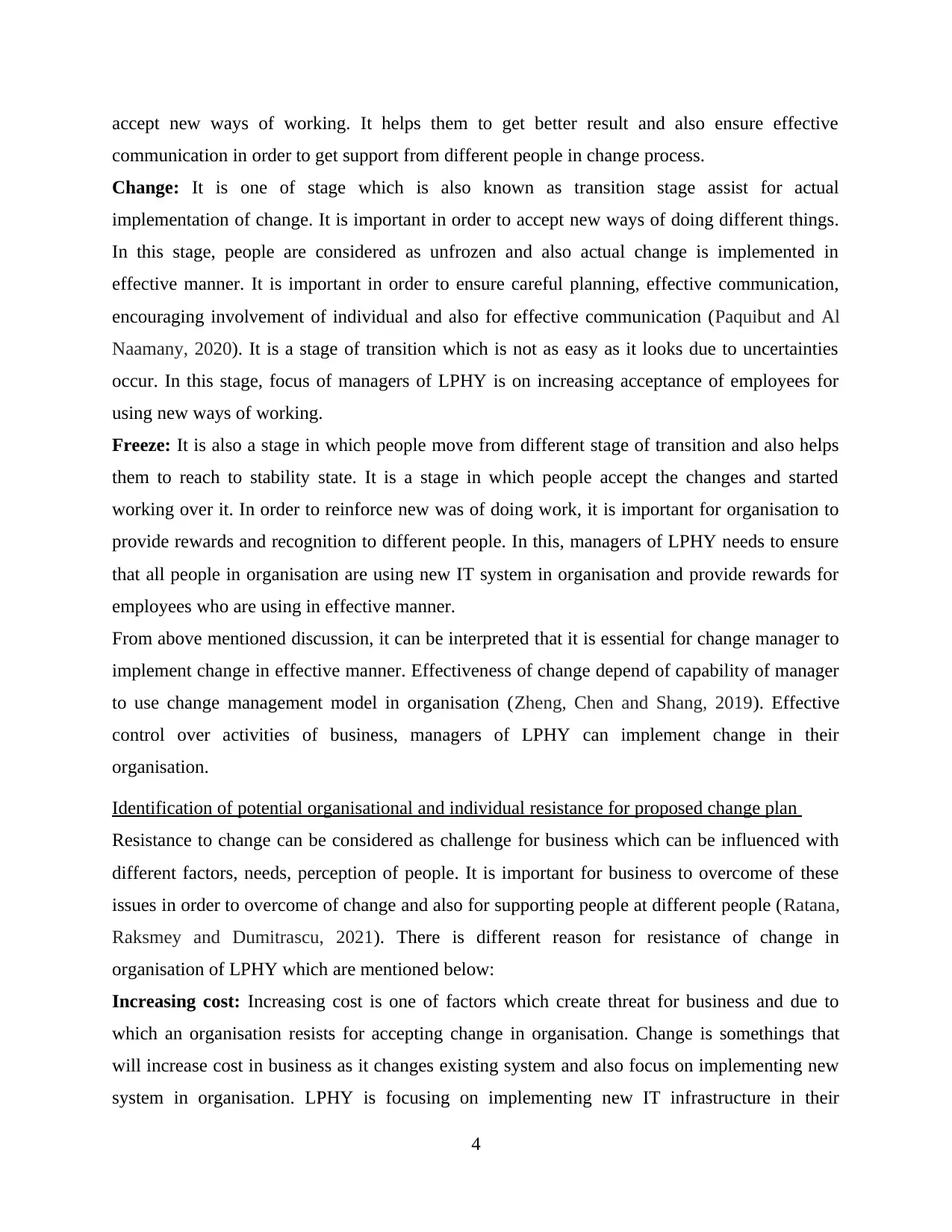
accept new ways of working. It helps them to get better result and also ensure effective
communication in order to get support from different people in change process.
Change: It is one of stage which is also known as transition stage assist for actual
implementation of change. It is important in order to accept new ways of doing different things.
In this stage, people are considered as unfrozen and also actual change is implemented in
effective manner. It is important in order to ensure careful planning, effective communication,
encouraging involvement of individual and also for effective communication (Paquibut and Al
Naamany, 2020). It is a stage of transition which is not as easy as it looks due to uncertainties
occur. In this stage, focus of managers of LPHY is on increasing acceptance of employees for
using new ways of working.
Freeze: It is also a stage in which people move from different stage of transition and also helps
them to reach to stability state. It is a stage in which people accept the changes and started
working over it. In order to reinforce new was of doing work, it is important for organisation to
provide rewards and recognition to different people. In this, managers of LPHY needs to ensure
that all people in organisation are using new IT system in organisation and provide rewards for
employees who are using in effective manner.
From above mentioned discussion, it can be interpreted that it is essential for change manager to
implement change in effective manner. Effectiveness of change depend of capability of manager
to use change management model in organisation (Zheng, Chen and Shang, 2019). Effective
control over activities of business, managers of LPHY can implement change in their
organisation.
Identification of potential organisational and individual resistance for proposed change plan
Resistance to change can be considered as challenge for business which can be influenced with
different factors, needs, perception of people. It is important for business to overcome of these
issues in order to overcome of change and also for supporting people at different people (Ratana,
Raksmey and Dumitrascu, 2021). There is different reason for resistance of change in
organisation of LPHY which are mentioned below:
Increasing cost: Increasing cost is one of factors which create threat for business and due to
which an organisation resists for accepting change in organisation. Change is somethings that
will increase cost in business as it changes existing system and also focus on implementing new
system in organisation. LPHY is focusing on implementing new IT infrastructure in their
4
communication in order to get support from different people in change process.
Change: It is one of stage which is also known as transition stage assist for actual
implementation of change. It is important in order to accept new ways of doing different things.
In this stage, people are considered as unfrozen and also actual change is implemented in
effective manner. It is important in order to ensure careful planning, effective communication,
encouraging involvement of individual and also for effective communication (Paquibut and Al
Naamany, 2020). It is a stage of transition which is not as easy as it looks due to uncertainties
occur. In this stage, focus of managers of LPHY is on increasing acceptance of employees for
using new ways of working.
Freeze: It is also a stage in which people move from different stage of transition and also helps
them to reach to stability state. It is a stage in which people accept the changes and started
working over it. In order to reinforce new was of doing work, it is important for organisation to
provide rewards and recognition to different people. In this, managers of LPHY needs to ensure
that all people in organisation are using new IT system in organisation and provide rewards for
employees who are using in effective manner.
From above mentioned discussion, it can be interpreted that it is essential for change manager to
implement change in effective manner. Effectiveness of change depend of capability of manager
to use change management model in organisation (Zheng, Chen and Shang, 2019). Effective
control over activities of business, managers of LPHY can implement change in their
organisation.
Identification of potential organisational and individual resistance for proposed change plan
Resistance to change can be considered as challenge for business which can be influenced with
different factors, needs, perception of people. It is important for business to overcome of these
issues in order to overcome of change and also for supporting people at different people (Ratana,
Raksmey and Dumitrascu, 2021). There is different reason for resistance of change in
organisation of LPHY which are mentioned below:
Increasing cost: Increasing cost is one of factors which create threat for business and due to
which an organisation resists for accepting change in organisation. Change is somethings that
will increase cost in business as it changes existing system and also focus on implementing new
system in organisation. LPHY is focusing on implementing new IT infrastructure in their
4
⊘ This is a preview!⊘
Do you want full access?
Subscribe today to unlock all pages.

Trusted by 1+ million students worldwide
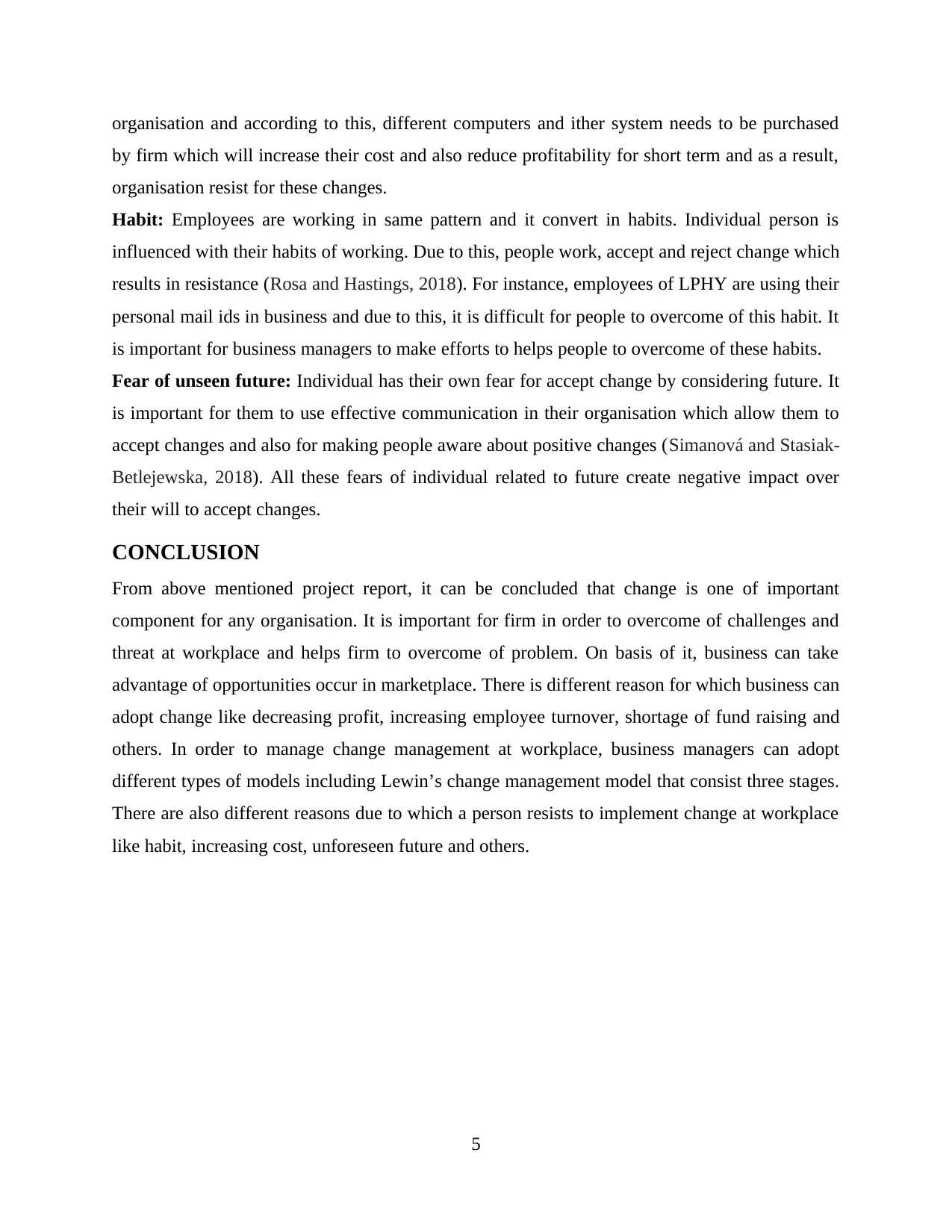
organisation and according to this, different computers and ither system needs to be purchased
by firm which will increase their cost and also reduce profitability for short term and as a result,
organisation resist for these changes.
Habit: Employees are working in same pattern and it convert in habits. Individual person is
influenced with their habits of working. Due to this, people work, accept and reject change which
results in resistance (Rosa and Hastings, 2018). For instance, employees of LPHY are using their
personal mail ids in business and due to this, it is difficult for people to overcome of this habit. It
is important for business managers to make efforts to helps people to overcome of these habits.
Fear of unseen future: Individual has their own fear for accept change by considering future. It
is important for them to use effective communication in their organisation which allow them to
accept changes and also for making people aware about positive changes (Simanová and Stasiak-
Betlejewska, 2018). All these fears of individual related to future create negative impact over
their will to accept changes.
CONCLUSION
From above mentioned project report, it can be concluded that change is one of important
component for any organisation. It is important for firm in order to overcome of challenges and
threat at workplace and helps firm to overcome of problem. On basis of it, business can take
advantage of opportunities occur in marketplace. There is different reason for which business can
adopt change like decreasing profit, increasing employee turnover, shortage of fund raising and
others. In order to manage change management at workplace, business managers can adopt
different types of models including Lewin’s change management model that consist three stages.
There are also different reasons due to which a person resists to implement change at workplace
like habit, increasing cost, unforeseen future and others.
5
by firm which will increase their cost and also reduce profitability for short term and as a result,
organisation resist for these changes.
Habit: Employees are working in same pattern and it convert in habits. Individual person is
influenced with their habits of working. Due to this, people work, accept and reject change which
results in resistance (Rosa and Hastings, 2018). For instance, employees of LPHY are using their
personal mail ids in business and due to this, it is difficult for people to overcome of this habit. It
is important for business managers to make efforts to helps people to overcome of these habits.
Fear of unseen future: Individual has their own fear for accept change by considering future. It
is important for them to use effective communication in their organisation which allow them to
accept changes and also for making people aware about positive changes (Simanová and Stasiak-
Betlejewska, 2018). All these fears of individual related to future create negative impact over
their will to accept changes.
CONCLUSION
From above mentioned project report, it can be concluded that change is one of important
component for any organisation. It is important for firm in order to overcome of challenges and
threat at workplace and helps firm to overcome of problem. On basis of it, business can take
advantage of opportunities occur in marketplace. There is different reason for which business can
adopt change like decreasing profit, increasing employee turnover, shortage of fund raising and
others. In order to manage change management at workplace, business managers can adopt
different types of models including Lewin’s change management model that consist three stages.
There are also different reasons due to which a person resists to implement change at workplace
like habit, increasing cost, unforeseen future and others.
5
Paraphrase This Document
Need a fresh take? Get an instant paraphrase of this document with our AI Paraphraser
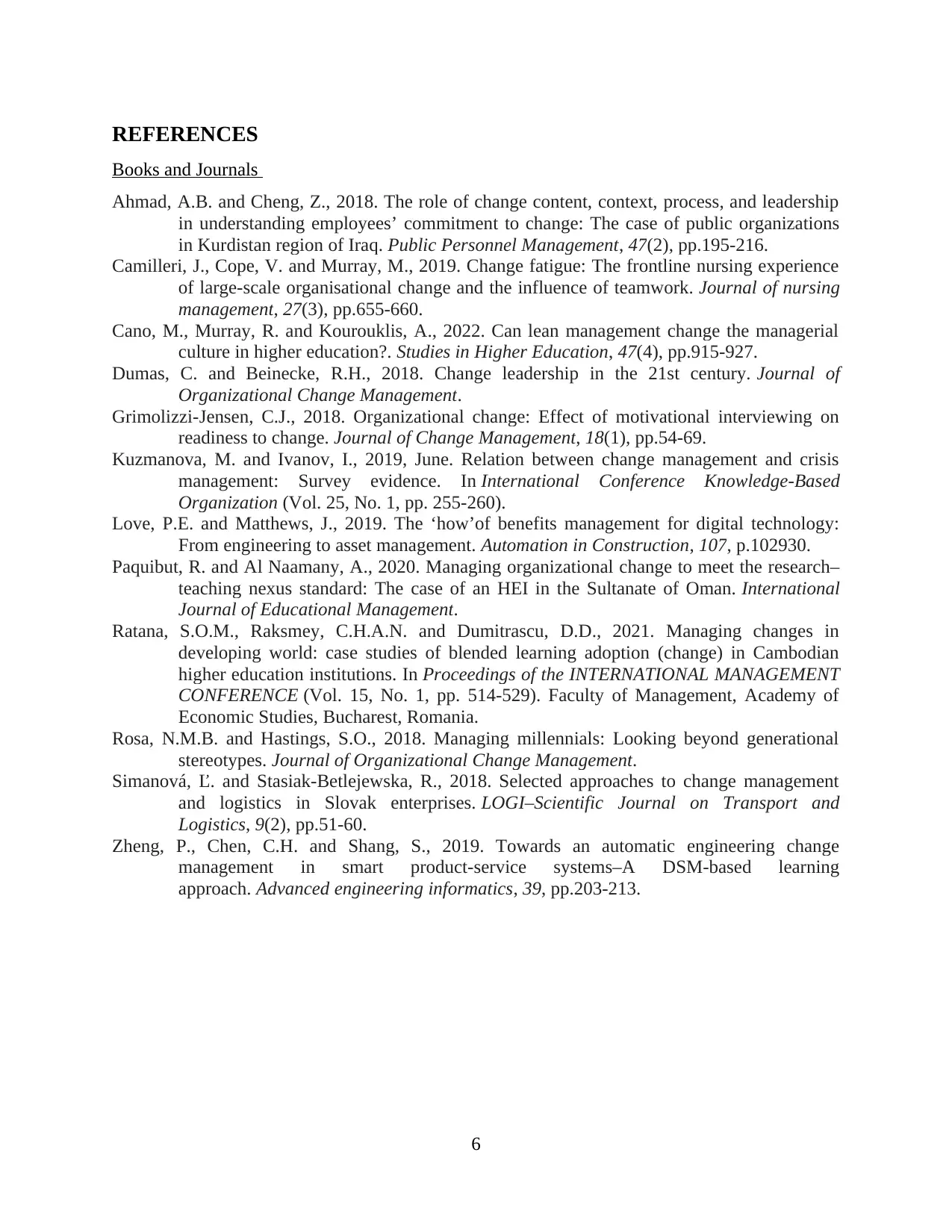
REFERENCES
Books and Journals
Ahmad, A.B. and Cheng, Z., 2018. The role of change content, context, process, and leadership
in understanding employees’ commitment to change: The case of public organizations
in Kurdistan region of Iraq. Public Personnel Management, 47(2), pp.195-216.
Camilleri, J., Cope, V. and Murray, M., 2019. Change fatigue: The frontline nursing experience
of large‐scale organisational change and the influence of teamwork. Journal of nursing
management, 27(3), pp.655-660.
Cano, M., Murray, R. and Kourouklis, A., 2022. Can lean management change the managerial
culture in higher education?. Studies in Higher Education, 47(4), pp.915-927.
Dumas, C. and Beinecke, R.H., 2018. Change leadership in the 21st century. Journal of
Organizational Change Management.
Grimolizzi-Jensen, C.J., 2018. Organizational change: Effect of motivational interviewing on
readiness to change. Journal of Change Management, 18(1), pp.54-69.
Kuzmanova, M. and Ivanov, I., 2019, June. Relation between change management and crisis
management: Survey evidence. In International Conference Knowledge-Based
Organization (Vol. 25, No. 1, pp. 255-260).
Love, P.E. and Matthews, J., 2019. The ‘how’of benefits management for digital technology:
From engineering to asset management. Automation in Construction, 107, p.102930.
Paquibut, R. and Al Naamany, A., 2020. Managing organizational change to meet the research–
teaching nexus standard: The case of an HEI in the Sultanate of Oman. International
Journal of Educational Management.
Ratana, S.O.M., Raksmey, C.H.A.N. and Dumitrascu, D.D., 2021. Managing changes in
developing world: case studies of blended learning adoption (change) in Cambodian
higher education institutions. In Proceedings of the INTERNATIONAL MANAGEMENT
CONFERENCE (Vol. 15, No. 1, pp. 514-529). Faculty of Management, Academy of
Economic Studies, Bucharest, Romania.
Rosa, N.M.B. and Hastings, S.O., 2018. Managing millennials: Looking beyond generational
stereotypes. Journal of Organizational Change Management.
Simanová, Ľ. and Stasiak-Betlejewska, R., 2018. Selected approaches to change management
and logistics in Slovak enterprises. LOGI–Scientific Journal on Transport and
Logistics, 9(2), pp.51-60.
Zheng, P., Chen, C.H. and Shang, S., 2019. Towards an automatic engineering change
management in smart product-service systems–A DSM-based learning
approach. Advanced engineering informatics, 39, pp.203-213.
6
Books and Journals
Ahmad, A.B. and Cheng, Z., 2018. The role of change content, context, process, and leadership
in understanding employees’ commitment to change: The case of public organizations
in Kurdistan region of Iraq. Public Personnel Management, 47(2), pp.195-216.
Camilleri, J., Cope, V. and Murray, M., 2019. Change fatigue: The frontline nursing experience
of large‐scale organisational change and the influence of teamwork. Journal of nursing
management, 27(3), pp.655-660.
Cano, M., Murray, R. and Kourouklis, A., 2022. Can lean management change the managerial
culture in higher education?. Studies in Higher Education, 47(4), pp.915-927.
Dumas, C. and Beinecke, R.H., 2018. Change leadership in the 21st century. Journal of
Organizational Change Management.
Grimolizzi-Jensen, C.J., 2018. Organizational change: Effect of motivational interviewing on
readiness to change. Journal of Change Management, 18(1), pp.54-69.
Kuzmanova, M. and Ivanov, I., 2019, June. Relation between change management and crisis
management: Survey evidence. In International Conference Knowledge-Based
Organization (Vol. 25, No. 1, pp. 255-260).
Love, P.E. and Matthews, J., 2019. The ‘how’of benefits management for digital technology:
From engineering to asset management. Automation in Construction, 107, p.102930.
Paquibut, R. and Al Naamany, A., 2020. Managing organizational change to meet the research–
teaching nexus standard: The case of an HEI in the Sultanate of Oman. International
Journal of Educational Management.
Ratana, S.O.M., Raksmey, C.H.A.N. and Dumitrascu, D.D., 2021. Managing changes in
developing world: case studies of blended learning adoption (change) in Cambodian
higher education institutions. In Proceedings of the INTERNATIONAL MANAGEMENT
CONFERENCE (Vol. 15, No. 1, pp. 514-529). Faculty of Management, Academy of
Economic Studies, Bucharest, Romania.
Rosa, N.M.B. and Hastings, S.O., 2018. Managing millennials: Looking beyond generational
stereotypes. Journal of Organizational Change Management.
Simanová, Ľ. and Stasiak-Betlejewska, R., 2018. Selected approaches to change management
and logistics in Slovak enterprises. LOGI–Scientific Journal on Transport and
Logistics, 9(2), pp.51-60.
Zheng, P., Chen, C.H. and Shang, S., 2019. Towards an automatic engineering change
management in smart product-service systems–A DSM-based learning
approach. Advanced engineering informatics, 39, pp.203-213.
6
1 out of 8
Related Documents
Your All-in-One AI-Powered Toolkit for Academic Success.
+13062052269
info@desklib.com
Available 24*7 on WhatsApp / Email
![[object Object]](/_next/static/media/star-bottom.7253800d.svg)
Unlock your academic potential
Copyright © 2020–2025 A2Z Services. All Rights Reserved. Developed and managed by ZUCOL.

